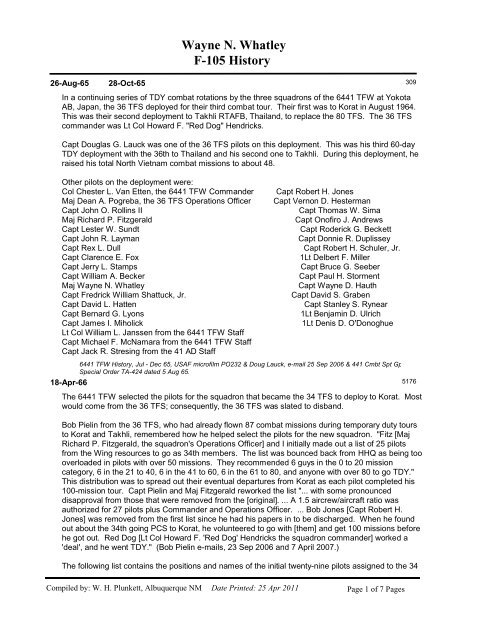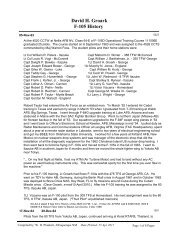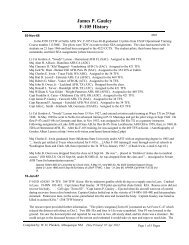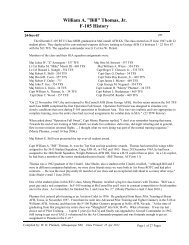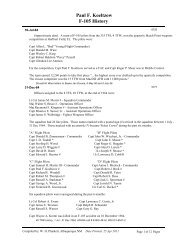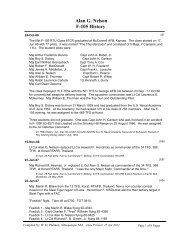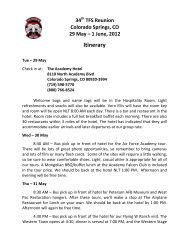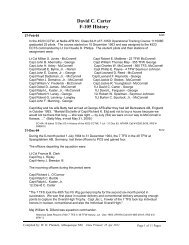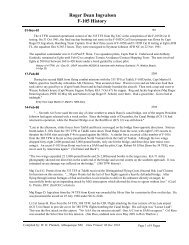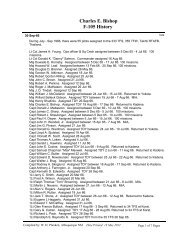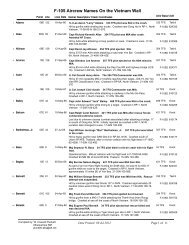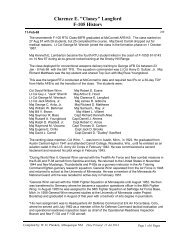Wayne N. Whatley F-105 History - 34th Tactical Fighter Squadron ...
Wayne N. Whatley F-105 History - 34th Tactical Fighter Squadron ...
Wayne N. Whatley F-105 History - 34th Tactical Fighter Squadron ...
Create successful ePaper yourself
Turn your PDF publications into a flip-book with our unique Google optimized e-Paper software.
26-Aug-65<br />
28-Oct-65<br />
<strong>Wayne</strong> N. <strong>Whatley</strong><br />
F-<strong>105</strong> <strong>History</strong><br />
In a continuing series of TDY combat rotations by the three squadrons of the 6441 TFW at Yokota<br />
AB, Japan, the 36 TFS deployed for their third combat tour. Their first was to Korat in August 1964.<br />
This was their second deployment to Takhli RTAFB, Thailand, to replace the 80 TFS. The 36 TFS<br />
commander was Lt Col Howard F. "Red Dog" Hendricks.<br />
Capt Douglas G. Lauck was one of the 36 TFS pilots on this deployment. This was his third 60-day<br />
TDY deployment with the 36th to Thailand and his second one to Takhli. During this deployment, he<br />
raised his total North Vietnam combat missions to about 48.<br />
Other pilots on the deployment were:<br />
Col Chester L. Van Etten, the 6441 TFW Commander Capt Robert H. Jones<br />
Maj Dean A. Pogreba, the 36 TFS Operations Officer Capt Vernon D. Hesterman<br />
Capt John O. Rollins II Capt Thomas W. Sima<br />
Maj Richard P. Fitzgerald Capt Onofiro J. Andrews<br />
Capt Lester W. Sundt Capt Roderick G. Beckett<br />
Capt John R. Layman Capt Donnie R. Duplissey<br />
Capt Rex L. Dull Capt Robert H. Schuler, Jr.<br />
Capt Clarence E. Fox 1Lt Delbert F. Miller<br />
Capt Jerry L. Stamps Capt Bruce G. Seeber<br />
Capt William A. Becker Capt Paul H. Storment<br />
Maj <strong>Wayne</strong> N. <strong>Whatley</strong> Capt <strong>Wayne</strong> D. Hauth<br />
Capt Fredrick William Shattuck, Jr. Capt David S. Graben<br />
Capt David L. Hatten Capt Stanley S. Rynear<br />
Capt Bernard G. Lyons 1Lt Benjamin D. Ulrich<br />
Capt James I. Miholick 1Lt Denis D. O'Donoghue<br />
Lt Col William L. Janssen from the 6441 TFW Staff<br />
Capt Michael F. McNamara from the 6441 TFW Staff<br />
Capt Jack R. Stresing from the 41 AD Staff<br />
6441 TFW <strong>History</strong>, Jul - Dec 65, USAF microfilm PO232 & Doug Lauck, e-mail 25 Sep 2006 & 441 Cmbt Spt Gp<br />
Special Order TA-424 dated 5 Aug 65.<br />
18-Apr-66<br />
5176<br />
The 6441 TFW selected the pilots for the squadron that became the 34 TFS to deploy to Korat. Most<br />
would come from the 36 TFS; consequently, the 36 TFS was slated to disband.<br />
Bob Pielin from the 36 TFS, who had already flown 87 combat missions during temporary duty tours<br />
to Korat and Takhli, remembered how he helped select the pilots for the new squadron. "Fitz [Maj<br />
Richard P. Fitzgerald, the squadron's Operations Officer] and I initially made out a list of 25 pilots<br />
from the Wing resources to go as <strong>34th</strong> members. The list was bounced back from HHQ as being too<br />
overloaded in pilots with over 50 missions. They recommended 6 guys in the 0 to 20 mission<br />
category, 6 in the 21 to 40, 6 in the 41 to 60, 6 in the 61 to 80, and anyone with over 80 to go TDY."<br />
This distribution was to spread out their eventual departures from Korat as each pilot completed his<br />
100-mission tour. Capt Pielin and Maj Fitzgerald reworked the list "... with some pronounced<br />
disapproval from those that were removed from the [original]. ... A 1.5 aircrew/aircraft ratio was<br />
authorized for 27 pilots plus Commander and Operations Officer. ... Bob Jones [Capt Robert H.<br />
Jones] was removed from the first list since he had his papers in to be discharged. When he found<br />
out about the <strong>34th</strong> going PCS to Korat, he volunteered to go with [them] and get 100 missions before<br />
he got out. Red Dog [Lt Col Howard F. 'Red Dog' Hendricks the squadron commander] worked a<br />
'deal', and he went TDY." (Bob Pielin e-mails, 23 Sep 2006 and 7 April 2007.)<br />
The following list contains the positions and names of the initial twenty-nine pilots assigned to the 34<br />
Compiled by: W. H. Plunkett, Albuquerque NM Date Printed: 25 Apr 2011<br />
Page 1 of 7 Pages<br />
309
<strong>Wayne</strong> N. <strong>Whatley</strong><br />
F-<strong>105</strong> <strong>History</strong><br />
TFS. This is the revised list after Capt Pielin and Maj Fitzgerald reworked their original to provide a<br />
broader base of experience. One of the pilots, Gordon Walcott, annotated his copy of the printed list,<br />
dated 18 April 1966, with this comment: "This was the original <strong>34th</strong> TFS crew roster when formed as<br />
an all-volunteer squadron from the 35 TFS, 36 TFS, and 80 TFS (Yokota AB, Japan)"<br />
Commander - Lt Col Howard F. "Red Dog" Hendricks who had been commander of the 36 TFS.<br />
Operations Officer - Maj Richard P. Fitzgerald<br />
India Flight Lima Flight<br />
Flight Commander - Maj <strong>Wayne</strong> N. <strong>Whatley</strong> Flight Commander - Capt James E. Hayes<br />
Capt Robin K. Nierste Capt Merrill R. Lewis, Jr.<br />
Capt James I. Miholick Capt Gordon M. Walcott<br />
Capt Douglas G. Lauck Capt Stanley S. Gunnersen<br />
Capt Robert H. Jones 1Lt John Bernard Sullivan III<br />
Capt Robert R. Reed<br />
Juliet Flight Metro Flight<br />
Flight Commander - Maj Kenneth T. Blank Flight Commander - Capt Robert D. Pielin<br />
Capt Carl L. Hamby Capt Alan K. Rutherford<br />
Capt Thomas H. Curtis Capt Ralph D. Watkins<br />
Capt David H. Groark Capt <strong>Wayne</strong> D. Hauth<br />
1Lt Phillip J. Kelley Capt Rainford "Ray" McMaster Tiffin<br />
Kilo Flight<br />
Flight Commander - Maj Jack R. Stresing<br />
Capt William O. Lessard<br />
Capt John R. Layman<br />
Capt Rex L. Dull<br />
Capt Clarence E. Fox<br />
1Lt Denis D. O'Donoghue<br />
E-mail from Monty Pharmer, 22 Sep 2006 forwarding letter to him from Lt Col (Ret) Gordon Walcott dated, 29 July<br />
1988, which included a roster of 36 TFS pilots, dated 18 April 1966.<br />
25-May-66<br />
4957<br />
On Wednesday morning, twenty F-<strong>105</strong>Ds (18 aircraft and 2 spares) now assigned to the 34 TFS left<br />
the 6441 TFW at Yokota for Kadena on the first leg of their movement to the 388 TFW at Korat. The<br />
aircraft took off in flights of four using call signs "Yule". Each flight departed Yokota at half-hour<br />
intervals beginning at 0800. The deployment's flight line-up consisted of:<br />
Call Acft Yokota Kadena Acft Maint<br />
Pilot Sign Tail No TO Time Arr Time Status at Kadena<br />
Lt Col Howard F. Hendricks Yule 01 62-4361 0800 0955 Tacan/Doppler probs<br />
Capt Robin K. Nierste Yule 02 62-4288 0800 0955 O/R<br />
Capt James I. Miholick Yule 03 62-4336 0800 0955 O/R<br />
Capt <strong>Wayne</strong> D. Hauth Yule 04 62-4303 0800 0955 Gnd blower inop<br />
Maj <strong>Wayne</strong> N. <strong>Whatley</strong> Yule 11 62-4306 0830 1025 O/R<br />
Capt Robert H. Jones Yule 12 62-4318 0830 1025 O/R<br />
Capt Robert R. Reed Yule 13 62-4308 0830 1025 Autopilot<br />
Capt Douglas G. Lauck Yule 14 62-4358 0830 1025 O/R<br />
Maj Kenneth T. Blank Yule 21 62-4370 0901 <strong>105</strong>8 O/R<br />
Compiled by: W. H. Plunkett, Albuquerque NM Date Printed: 25 Apr 2011<br />
Page 2 of 7 Pages
<strong>Wayne</strong> N. <strong>Whatley</strong><br />
F-<strong>105</strong> <strong>History</strong><br />
Capt Thomas H. Curtis Yule 22 62-4380 0901 <strong>105</strong>8 O/R<br />
Capt Carl L. Hamby Yule 23 62-4364 0901 <strong>105</strong>8 O/R<br />
1Lt Phillip J. Kelly Yule 24 62-4277 0901 <strong>105</strong>8 O/R<br />
Capt Alan K. Rutherford Yule 31 62-4270 0930 1134 Autopilot<br />
Capt Rex L. Dull Yule 32 62-4312 0930 1134 O/R<br />
Capt Ralph D. Watkins Yule 33 62-4378 0930 1134 CIN<br />
1Lt John B. Sullivan III Yule 34 62-4356 0930 1134 Fire Ctrl/Elec<br />
Capt James E. Hayes Yule 41 62-4352 1000 1200 Fire Ctrl<br />
Maj Jack R. Stresing Yule 42 61-0132 1000 1200 O/R<br />
Capt Andy Olman Yule 43 62-4379 1000 1200 Fuel Leak<br />
Capt Robert D. Reichardt Yule 44 62-4354 1000 1200 O/R<br />
(<strong>History</strong> of the 6441 TFW, 1 Apr 65 to 15 Nov 66, Supporting Documents, Mobility Control Center<br />
Log, pg 6, in AFHRA folder K-WG-6441-HI, IRIS# 0462464.)<br />
Capt Alan K. Rutherford was one of the pilots on the deployment. "I recall so well how we formed up<br />
with 16 Thuds and midst many tears (from wives) and go get um's from the troops we launched to the<br />
war. We were going to 'kill the Cong'. We intended to overnight at Kadena, and then launch the next<br />
day with the squadron to Korat. Needless to say it got drunk and rowdy that night ...". (Al Rutherford,<br />
e-mail, 21 Sep 2006.)<br />
Capt Douglas G. Lauck was another of the 34 TFS pilots moving to Korat. "We packed our<br />
household goods [at Yokota] and sent them along with our cars back to the States. Our wives and<br />
dependents had flights booked back to the States." (Doug Lauck, e-mail 21 Sep 2006.)<br />
The pilots from the 34 TFS were to join with pilots from the 13 TFS at Kadena on 25 May and deploy<br />
to Korat. Unfortunately, circumstances required the <strong>34th</strong> pilots at Kadena to return to Yokota on 26<br />
May.<br />
In the 13 TFS, "the squadron was cocked to move as planned on the 25th of May, but a staying order<br />
was received, delaying departure for thirty days. Rumors were rife that perhaps the move would not<br />
be made at all. Unfortunately, on the basis of the rumors and the lack of further communications,<br />
after numerous inquires to higher headquarters on the subject, many members of the new squadron<br />
cancelled proceedings to return their dependents to the United States. As a result, when the order to<br />
deploy on 23 June was received with a week's advance notice, many dependents were left to arrange<br />
their own moves. Much help was rendered by friends and Wing personnel, of course, to facilitate<br />
these peoples' departure. On 23 June, support personnel departed for Korat via C-130. Aircrews<br />
departed the following day."<br />
388 TFW <strong>History</strong>, Jul - Dec 66, USAF microfilm NO583 frame 1742 & 44 TFS history, 1 Jan 65 - 30 June 1967, pp<br />
4 - 5.<br />
30-Jun-66<br />
866<br />
"Oil depots near Hanoi were struck for the second straight day. USAF F-<strong>105</strong>s hit the Nguyen Khe<br />
depot 7 1/2 miles from the city. Another flight of F-<strong>105</strong>s struck the Viet Tri POL storage area 28<br />
miles northwest of the city. Navy aircraft hit the Bac Giang POL dump (JCS 51.11) 25 miles<br />
northeast of Hanoi."<br />
"Over the next two days, U.S. pilots returned to hit the remaining key POL installations. General<br />
Moore dispatched two separate missions, each consisting of twelve F-<strong>105</strong> strike and support aircraft,<br />
against the POL storage areas at Nguyen Khe (JCS 51) and Viet Tri (JCS 51.14), seven miles north<br />
and twenty-eight miles northwest of Hanoi. The pilots rained sixty-two 750-pound bombs on the first<br />
Compiled by: W. H. Plunkett, Albuquerque NM Date Printed: 25 Apr 2011<br />
Page 3 of 7 Pages
<strong>Wayne</strong> N. <strong>Whatley</strong><br />
F-<strong>105</strong> <strong>History</strong><br />
and thirty -two on the second, with supporting aircraft plastering antiaircraft positions in each area<br />
with CBU-24 cluster bombs. Only one Thunderchief was damaged and the pilot, who ejected, was<br />
recovered safely. The dual mission proved only marginally successful, however, destroying only 20<br />
percent of the target area at Nguyen Khe and 15 percent at Viet Tri."<br />
Maj <strong>Wayne</strong> N. <strong>Whatley</strong>, 34 TFS, 388 TFW, was a strike pilot flying against one of the POL sites. He<br />
was awarded the Air Force Cross for his "extraordinary heroism". " ... Major <strong>Whatley</strong> led a flight of<br />
four F-<strong>105</strong> aircraft against an extremely heavily defended petroleum, oil, and lubricant storage<br />
complex in North Vietnam. By exhibiting extraordinary flying ability, leadership qualities, and<br />
personal bravery in the face of intense hostile fire, Major <strong>Whatley</strong> successfully struck the assigned<br />
target, thus contributing greatly to the objectives of his country. Although sustaining hits on his<br />
aircraft, Major <strong>Whatley</strong>, disregarding his personal safety, stayed with his downed wingman and<br />
directed a successful rescue operation ... ". The downed wingman was Capt Robin K. Nierste.<br />
Also on this day the Navy bombed the Bac Giang POL dump (JCS 51.11) near the Viet Tri area.<br />
(Corona Harvest Chronology of Significant Airpower Events in Southeast Asia, 1954 - 1967, pg 119.)<br />
Seventh Air Force Chronology 1 July 65 - 30 June 1966 CHECO 66-0044 & "Gradual Failure: The Air War over<br />
North Vietnam: 1965 - 1966", pg 292 & extract from "For Extraordinary Heroism - The Air Force Cross" by Maj<br />
Jeffery B. Floyd, provided by Ron Thurlow.<br />
17-Aug-66<br />
Four F-<strong>105</strong> pilots from the 34 TFS from Korat formed "Anvil" flight that was part of a large 388 TFW<br />
strike force targeted against the Nguyen Khe POL storage area (JCS 51) in Route Pack 6 north of<br />
Hanoi. The line up for Anvil flight was:<br />
"Anvil 01" - Maj <strong>Wayne</strong> N. <strong>Whatley</strong><br />
"Anvil 02" - Capt Douglas G. Lauck<br />
"Anvil 03" - Capt Robert R. Reed<br />
"Anvil 04" - Capt James J. Miholick<br />
It was the 87th combat mission for Capt Lauck and he remembered it as, "... probably one of the<br />
more exciting missions I flew." The route to the target was across Laos and South Vietnam below the<br />
DMZ with refueling in the Brown Anchor track over the Gulf of Tonkin. The strike force then headed<br />
north with intentions of turning west at the "Wart on the Elephant's Ear", an island landmark below<br />
China, to approach the target from the north.<br />
Shortly after taking on fuel from the KC-135 tankers, the four F-<strong>105</strong>Ds in Anvil flight broke off from<br />
the rest of the strike force and headed northwest dropping down into RP 3 for a high-speed low-level<br />
approach to the target from the south. As the flight crossed into North Vietnam, Anvil 4 lost his radio<br />
and aborted the mission. Anvil 3 accompanied him back to Korat while Anvil 1 and 2 continued north<br />
with their loads of six 750-pound bombs.<br />
When the two planes entered Pack 6 using low-level terrain masking, they found clear but hazy<br />
weather allowing 5 miles visibility. As they skirted Hanoi to the east, they met heavy AAA and got<br />
warnings of SAM launches on their RHAW gear. Doug Lauck recalled, "... stuff began flying every<br />
which way." The two pilots didn't realize until later that the strike force had aborted at their turning<br />
point when they ran into thunderstorms that blocked their route to the target. The force turned south<br />
and, accompanied by EB-66s with their standoff jammers and other support aircraft, headed home.<br />
Anvil 1 and 2 became the only planes in the area and the North Vietnamese defenses, primed for a<br />
large strike force, opened up on them.<br />
Strangely, the flak stopped just before Anvil 1 popped up to 12,000 feet, rolled in to drop his six<br />
bombs on the POL storage site, then pulled out at 3,000 feet. A minute later, as Capt Lauck pulled<br />
Compiled by: W. H. Plunkett, Albuquerque NM Date Printed: 25 Apr 2011<br />
Page 4 of 7 Pages<br />
5209
<strong>Wayne</strong> N. <strong>Whatley</strong><br />
F-<strong>105</strong> <strong>History</strong><br />
up from his bomb run, he spotted a silver MiG-17 with Chinese markings flying at 5,000 feet heading<br />
toward his flight lead. The MiG was firing his nose guns and Lauck could see shells bursting. He<br />
called, "Anvil 1 break -- you have a MiG closing." Maj <strong>Whatley</strong> punched off his tanks and racks, hit<br />
afterburner, and headed for the deck in a 4.5-G turn. The MiG pilot cut into his turn and continued to<br />
close on Anvil 1 then fired again when he was 4,000 feet away. The MiG closed to 1,500 feet still<br />
firing. Anvil 1 took it lower -- so low "he had to pull up to avoid rice paddy dikes."<br />
Capt Lauck began chasing the MiG-17 that was still pursuing his flight lead. The three planes headed<br />
toward China and may have crossed the border during the battle. Lauck tried to set up his gun sight<br />
for air-to-air firing but didn't have time to properly reset the five cockpit switches in his F-<strong>105</strong> to get<br />
his sight out of air-to-ground mode. He maneuvered to put the MiG in the center of his windscreen<br />
and began firing his 20-mm cannon. Anvil 1 crossed in front of the MiG and Lauck let off the trigger<br />
after firing 600 rounds. His slugs missed their target and to avoid an overshoot, he barrel rolled up<br />
and over the MiG. Both F-<strong>105</strong> pilots turned south, went supersonic, and outran the MiG-17, which<br />
gave up the chase.<br />
Their ordeal was not yet over since they still had to get out of North Vietnam; and Anvil 1 was running<br />
short of fuel. During his approach to the target, he had mistakenly used gas from his bomb-bay tank<br />
instead of his external tanks and, when he punched off his wing tanks, had depleted much of his<br />
remaining fuel. To make matters worse, most of the airborne tankers had left their orbits and weren't<br />
in position to hook up with the two F-<strong>105</strong>s. Calling on a discrete frequency, the two pilots finally<br />
reached a tanker willing to fly into Laos to meet them. With only 800 pounds of fuel, Anvil 1<br />
connected with the KC-135 over the Plain of Jars in northern Laos and took on enough gas for both F-<br />
<strong>105</strong>s to land safely at Korat.<br />
The <strong>Fighter</strong> Weapons Center history described this event this way. "Anvil flight, four F-<strong>105</strong>s, were<br />
attacking a target in the vicinity of 21-10N and <strong>105</strong>-54E. As Anvil 1 pulled off the target, Anvil four<br />
called a MiG-17 at Anvil 1's seven o'clock position, closing at 5,000 feet AGL. Anvil 1 lit AB,<br />
jettisoned tanks, and began a 400 K, 4.5 G left turn. The MiG stayed inside the turn, closing rapidly,<br />
and firing bursts from ranges of 4,000 ft down to 1,500 ft. Anvil 1 dove to ground level and the MiG<br />
followed, still firing. During this time, Anvil 4 had come off the target, engaged AB and had closed on<br />
the engagement at 600 K plus. Anvil 4 closed on the MiG (about 65 K overtake in firing range) and<br />
began firing at 1,500 ft range. Anvil 4 had not repositioned all necessary switches and, consequently,<br />
did not have computing gunsight. Anvil 4 fired 75 rounds of 20-mm at MiG and then ceased fire<br />
because Anvil 1 had jinked into the line of his fire in front of the MiG. Anvil 1 and 4 accelerated away<br />
from the MiG and departed the area."<br />
The two pilots later learned from reconnaissance photos that their bombs had failed to damage their<br />
POL target. However, their harrowing experience wasn't a total waste. Capt Lauck briefed other<br />
pilots in the wing on how he had simply centered the MiG in his windscreen when he didn't have time<br />
to reset his gun sight. The next day, 18 August 1966, Maj Kenneth T. Blank, also from the 34 TFS<br />
flying as "Honda 02", used the briefed technique to shoot down a MiG-17 under similar circumstances.<br />
Doug Lauck, e-mails 11 and 14 April 2007 & Red Baron I Vol II, Event II-33 pp 125 - 126 & USAF <strong>Tactical</strong> <strong>Fighter</strong><br />
Weapons Center Deputy For Combat Analysis Bulletin 7, AFHRA Call # K417.316 IRIS # 503560, pg 7.<br />
31-Oct-66<br />
5152<br />
Six pilots assigned to the 34 TFS in the 388 TFW at Korat completed flying 100 missions during<br />
October 1966. They were:<br />
Maj <strong>Wayne</strong> N. <strong>Whatley</strong><br />
Maj Jack R. Stresing<br />
Maj James E. Hayes<br />
Capt Alan K. Rutherford<br />
Compiled by: W. H. Plunkett, Albuquerque NM Date Printed: 25 Apr 2011<br />
Page 5 of 7 Pages
Capt Thomas H. Curtis<br />
Capt Robert R. Reed<br />
<strong>Wayne</strong> N. <strong>Whatley</strong><br />
F-<strong>105</strong> <strong>History</strong><br />
Capt Reed was next assigned to the Armament Development Test Center (AFSC) at Eglin AFB, FL.<br />
"For the next five years, I had the best flying assignment in the USAF -- flying two and three different<br />
kinds of aircraft -- dropping all the new experimental conventional ordnance, and no one was shooting<br />
back! Indeed happiness! ... While at Eglin, I had the unique pleasure of flying the Thud concurrently<br />
with the F-100 D/F, A-37B and the F-4 C/D/E model. This enabled me to, somewhat objectively,<br />
compare the qualities of the aircraft ... . The F-<strong>105</strong> is still the finest weapon system I have flown, It<br />
carried me home from some 1500 of my 4500 total hours, virtually without any problem --- that I did<br />
not cause.<br />
"My last flight in the Thud was in December 1971, just prior to my posting to an 'exchange tour' with<br />
the RAF at Manby, Lincolnshire, England -- another hardship tour to be sure, but someone has to do<br />
it !!???" Bob Reed accumulated 1187.4 flying hours in the F-<strong>105</strong>.<br />
34 TFS web site on 2 April 2007 at http://s88204154.onlinehome.us.34tfs/scarf.htm & Bob Reed letter dated March<br />
28, 1988 to Bauke Jan Douma.<br />
01-Dec-66<br />
2360<br />
The January 1967 issue of Republic's "Thunderchief Worldwide Report" included several recent<br />
awards and decorations for F-<strong>105</strong> pilots.<br />
Maj Kenneth T. Blank from the 34 TFS flew his 100th mission and reported to Nellis AFB.<br />
Maj <strong>Wayne</strong> N. <strong>Whatley</strong>, also from the 34 TFS, earned an Air Force Cross for extraordinary heroism.<br />
"<strong>Whatley</strong>, now a test pilot for the San Antonio Air Materiel Area, won the medal for leading an F-<strong>105</strong><br />
flight against a fuel depot in North Vietnam."<br />
"Eleven F-<strong>105</strong> pilots, [actually 10 pilots and one EWO] aggregating more than 2,700 combat flying<br />
hours, joined in an impressive formation flyby recently marking the end of a significant tour of duty for<br />
each. The 11 flyers were returning from their 100th combat mission over North Vietnam. Ten of the<br />
group were assigned to the same tactical fighter squadron - making the occasion an unusual first for<br />
that unit [the 13 TFS]. The organization holds the day in special regard, since a dozen 'graduates' in<br />
a month's time is unusual, and that many in a single day is an extreme rarity. On their final mission,<br />
the group flew in three separate raids then, upon completion, they regrouped for a low-level flyby<br />
over their home base [Korat]. The 100-mission pilots [and one EWO] in the flyby were:"<br />
13 TFS<br />
Maj Frederic C. Hiebert<br />
1Lt Roger J. Hagstrom<br />
Capt George H. Vipond<br />
Capt Roger L. Counts<br />
1Lt Jerry L. Garner<br />
1Lt Maxie A. Hatcher, Jr.<br />
Capt Charles H. Haberstich<br />
1Lt Russell M. Lanning<br />
Maj Richard D. Westcott - Wild Weasel pilot (WW# 76)<br />
Capt Herbert L. Friesen - Wild Weasel EWO (WW # 81)<br />
34 TFS<br />
Capt Duane H. Zieg<br />
"Earlier that same day, four pilots assigned to another squadron [421 TFS] under the same tactical<br />
Compiled by: W. H. Plunkett, Albuquerque NM Date Printed: 25 Apr 2011<br />
Page 6 of 7 Pages
<strong>Wayne</strong> N. <strong>Whatley</strong><br />
F-<strong>105</strong> <strong>History</strong><br />
fighter wing [388 TFW] completed their 100 missions, making a total of 15 in a single day for the<br />
unit." The pilots were:<br />
Maj William F. Loyd, Jr.<br />
Maj Daniel G. McIntosh<br />
1Lt Edwin L. Harvey<br />
Capt Harry E. Mattoon<br />
"Seventeen F-<strong>105</strong> pilots, ... who completed 100 missions over North Vietnam, were presented with<br />
certificates at an informal session held in Florida this month. Making the presentation was Doug<br />
Meadowcroft, Republic program manager." The pilots and their SEA squadrons were:<br />
Maj Hansel W. "Turk"Turley - 13 TFS<br />
Capt Jimmy D. Ginger - 13 TFS<br />
Maj Douglas D. Brenner - 333 TFS<br />
1Lt Thomas A. Gibbs - 469 TFS<br />
Capt Robert W. Davis - 354 TFS<br />
Capt Ralph A. Hanson - 354 TFS<br />
Capt Cecil W. Powell - 354 TFS<br />
Lt Col Ralph A. Ritteman - 333 TFS<br />
Maj John J. "Jack" Gaudion - 469 TFS<br />
Maj Frederick B. Green - 354 TFS<br />
Lt Col Charles W. Barnett - 421 TFS<br />
Lt Col Kenneth L. Skeen - 357 TFS<br />
Five of the 17 pilots had flown their 100th mission while assigned to the 34 TFS:<br />
Capt David H. Groark<br />
Maj Jack R. Stresing<br />
Capt James E. Hayes<br />
Capt Allan K. Rutherford<br />
Capt Robert R. Reed<br />
Thunderchief Worldwide Report, Vol II No 5, Jan 67.<br />
19-Sep-07<br />
"<strong>Wayne</strong> N. <strong>Whatley</strong> died on September 19, 2007, and was buried at the BG William C. Doyle<br />
Veteran's Memorial Cemetery in Wrightstown, New Jersey."<br />
http://www.veterantributes.org/TributeDetail.asp?ID=778<br />
Compiled by: W. H. Plunkett, Albuquerque NM Date Printed: 25 Apr 2011<br />
Page 7 of 7 Pages<br />
6817


